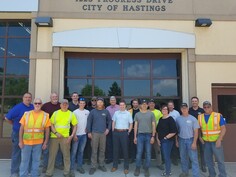Latest News
City of Hastings Public Works Operators Program

Article submitted by Cody Mathisen, PE, Principal Engineer, City of Hastings
The City of Hastings Public Works Department implemented a change to its staffing structure of Public Works employees in the latter half of the 2000s that continues to improve flexibility in operations and provide growth opportunities for staff today in 2021.
Up until the mid-2000s, the department was divided into street and utility departments much like it is in similarly sized communities in the Twin Cities. Each department had a supervisor and superintendent overseeing their respective divisions as well as designated utility operators and designated street operators. In total, this structure consisted of four management positions and ten operators - five serving in each department. As a handful of retirements were becoming imminent, it created concern with the loss of experience brought by those departures, but also an opportunity to explore an updated structure to best serve the City of Hastings moving forward.
As a result, it was determined that combining the departments and ultimately giving staff the option to become public works operators as opposed to strictly street or utility operators, would open doors for individuals to advance with dual expertise while also addressing the overall needs of the department for skills and abilities that could serve all operations. All existing operators within their respective departments were given the option to pursue the public works operator title or retain their titles in designated departments. At that time, three operators elected to stay within their existing specialties. Today, these individuals successfully continue on in those roles as the go-to experts for issues in their field.
The public works operator progression in the City of Hastings contains a 6-step program and it is required that an employee achieves the first four steps within designated timelines as they continue their employment with the city. As part of the first four steps of the program, public works operators are required to obtain and continue advancing licensure in the operation of sanitary sewer, water supply, commercial vehicles, and various heavy equipment. In addition to these licenses, public works operators are also required to complete certifications in pesticide application, tree inspections, and road salt application. The final area of expertise obtained by these operators is in the maintenance and operation of the hydro-electric plant located in town along the Mississippi River which is unique to the City of Hastings. Operators are responsible for regularly working in conjunction with the Army Corps of Engineers to regulate flows through the plant and monitor levels of the river in this reach. Step 5 of the program, which is encouraged but not required, includes the acquisition and maintenance of a Class B Water license and Class SB sewer license. The sixth and final step of the program is achieved when an employee completes the APWA Minnesota Chapter Public Works Certificate Program.
As with any organizational change the public works operator structure created new challenges different than those that came before; however, the overall momentum of the switch has been positive and the goal of having a more dynamic team has been largely achieved. From an efficiency standpoint, where four management and ten total operator positions were previously required, today the department operates successfully with only two managers and eleven total operators, six of whom are public works operators. The interchangeable skills of the public works operators group allow the department to focus on the daily, weekly, or seasonal task that is most pressing and do so with a larger number of trained staff than the previously smaller, separated departments. In addition, with a more uniform skill set across the department, this has simplified the process of filling in for employees who are sick or on vacation making absences less impactful. The new program has also allowed for a more equitable allocation of essential duties and on-call responsibilities that previously were a heavier burden for only one side of the department at a given time.
Possibly the most important and final benefit that the new public works operator program has generated for existing and new staff is the ability for internal advancement. The City of Hastings does not limit or restrict the number of public works operators at any given level of the 6-step program, thereby making upward mobility an option for everyone. Under the previous organizational structure, employees may have found themselves waiting for a retirement or other circumstance to create an opening for a position higher than their own within a given department. Allowing for advancement without this type of criteria has created a more positive dynamic within Public Works and allows individuals greater opportunities to control their own next steps.
The wide variety of hats needing to be worn by the operators will continue to be a moving target which certainly holds true for many similar departments throughout the State of Minnesota. The public works operator program in Hastings has proved to be a successful structure in combatting these ever-evolving challenges and the city continues to be thankful for the essential work these operators put in each day!
What's New
-

Young Professionals Spotlight
March 25, 2024
-

APWA-MN Education Programs
March 25, 2024
-
Apply for the Young Professionals Stipend: Attend PWX Atlanta
February 23, 2024



